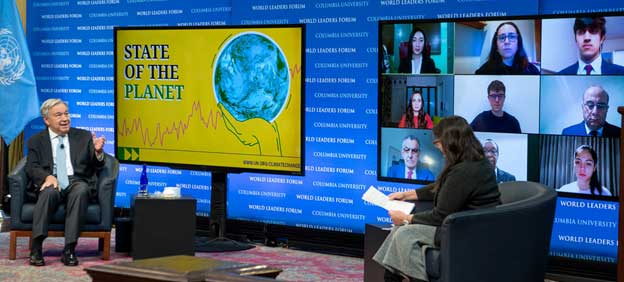We are Facing a Climate Emergency, Warns UN Chief

UNITED NATIONS, Jan 26 (IPS) - Antonio Guterres, the Secretary-General of the United Nations, in an address to the Climate Adaptation SummitWe begin this year with a heightened awareness of the importance of resilience. The COVID-19 pandemic has reminded us that we cannot afford to ignore known risks.
Climate disruption is a risk we are well aware of. The science has never been clearer.
We are facing a climate emergency.
We are already witnessing unprecedented climate extremes and volatility, affecting lives and livelihoods on all continents.
According to the World Meteorological Organization, there have been more than 11,000 disasters due to weather, climate and water-related hazards over the past 50 years at a cost of some $3.6 trillion US dollars.
Extreme weather and climate-related hazards have also killed more than 410,000 people in the past decade, the vast majority in low and lower middle-income countries. That is why I have called for a breakthrough on adaptation and resilience.
We need the trillions of taxpayers’ dollars funding the recovery from the COVID-19 pandemic to jump-start the low-carbon, high-resilience future we need.
But recovery cannot only be for the developed world. We must expand the provision of liquidity and debt relief instruments to developing and middle-income countries that lack the resources to relaunch their economies in a sustainable and inclusive way.
I see five priorities to guarantee adaptation and resilience.
First, donor countries and multilateral, regional and national development banks need to significantly increase the volume and predictability of their finance for adaptation and resilience.
The recent United Nations Environment Programme Adaptation Gap Report calculates annual adaptation costs in developing countries alone to be in the range of $70 billion US dollars.
These figures are likely to reach $140 or eventually up to 300 billion US dollars in 2030 and the range between $280 and 500 billion in 2050. But huge gaps remain on financing for adaptation in developing countries.
That is why I have called for 50 per cent of the total share of climate finance provided by all developed countries and multilateral development banks to be allocated to adaptation and resilience in developing countries. Adaptation cannot be the neglected half of the climate equation.
The African Development Bank set the bar in 2019 by allocating over half of its climate finance to adaptation. I urge all donors and multilateral development banks to commit to this goal by COP26 and deliver on it at least by 2024.
I welcome today’s commitment by Prime Minister Mark Rutte on behalf of the Government of the Netherlands. Let us remember that developed countries must meet the commitments made in the Paris Agreement to mobilize $100 billion US dollars a year from private and public sources for mitigation and adaptation in developing countries.
Second, all budget allocations and investment decisions need to be climate-resilient.
Climate risk must be embedded in all procurement processes, particularly for infrastructure. Developing countries must receive the necessary support and the tools to achieve this. The United Nations system is ready to support this effort worldwide.
Third, we need to significantly scale-up existing catastrophe-triggered financial instruments such as the Caribbean Catastrophe Risk Insurance Facility and the African Risk Capacity.
I also call on donors, the multilateral development banks and private finance institutions to work with vulnerable countries on developing new instruments with innovation to incentivize investments in resilience building.
For every dollar invested in climate resilient infrastructure, six dollars can be saved, as Prime Minister Mark Rutte just said.
Fourth, we need to ease access to finance, especially for the most vulnerable, and expand debt relief initiatives. The share for Least Developed Countries and Small Island Developing States in total climate finance remains small, representing only 14 per cent and 2 per cent of flows respectively.
These countries stand on the frontline of the climate crisis, yet, due to size and capacity constraints, they face significant challenges in accessing climate finance to build resilience.
There must be a collective effort to remove these obstacles.
Finally, we need to support regional adaptation and resilience initiatives.
This would allow, for example, debt-for-adaptation swaps, for example for the Caribbean or the Pacific Islands, and provide much needed liquidity to vulnerable countries in dire need.
Support for adaptation and resilience is a moral, economic and social imperative.
Today, one person in three is still not adequately covered by early warning systems, and risk-informed early approaches are not at the scale required.
As illustrated by the Global Commission on Adaptation, just 24 hours warning of a coming storm or heatwave can cut the ensuing damage by 30 per cent. We need to work together to ensure full global coverage by early warning systems to help minimize these losses.
We have the tools, skills and opportunity to deliver “more, faster and better” adaptation actions. I hope this summit helps to secure the breakthrough on adaptation and resilience that is needed and that it leads to ambitious outcomes at COP 26.
Let us live up to our responsibilities and jointly change course towards a sustainable, fair and resilient future.
Follow @IPSNewsUNBureau
Follow IPS New UN Bureau on Instagram
© Inter Press Service (2021) — All Rights Reserved. Original source: Inter Press Service
 Global Issues
Global Issues